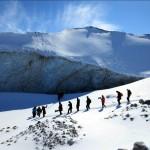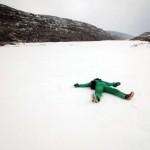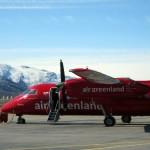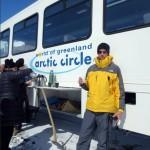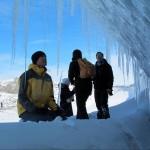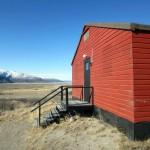 Leaving the comfort of blue skies at 37,000 feet, above a thick cloud layer, we started our slow descent down into Greenland. It was hard to believe that we were actually stopping in Greenland, a place that I had only flown over so many times between the USA and Europe. It isn’t a place I ever thought I would actually stop in. I always thought it was a place where no one ever went, somewhere inhospitable to life. It was hard to believe we were not making an emergency landing on a transcontinental flight, but Greenland was actually our destination.
Leaving the comfort of blue skies at 37,000 feet, above a thick cloud layer, we started our slow descent down into Greenland. It was hard to believe that we were actually stopping in Greenland, a place that I had only flown over so many times between the USA and Europe. It isn’t a place I ever thought I would actually stop in. I always thought it was a place where no one ever went, somewhere inhospitable to life. It was hard to believe we were not making an emergency landing on a transcontinental flight, but Greenland was actually our destination.
Once we were in the clouds, the nervous anticipation of seeing a new place, not knowing exactly what to expect, really started building. The passengers anxiously peered out the windows trying to get the first glimpse of this unknown place. Finally, we saw huge expanses of ice, broken up by brown hills and mountains, with rocks strewn all about. It looked like we were coming in for landing on another planet. As the Air Greenland Airbus 330 slowly came in for landing, making its way up a long glacier carved valley, the plane grew very quiet, but upon a smooth landing there was a huge sigh of relief and a spontaneous eruption of applause. We had made it to this other world, so little touristed and truly remote.
The arctic air was chilling as we left the airplane, descending the stairs, to the tarmac. The first photos of the airplane with the frozen hills in the background were impressive. After checking into our lodge, the Hostel “Old Camp” and attending a brief introductory meeting, our first excursion began. A sightseeing tour of the port, the surrounding hills, a visit to the Sanderstrom Scatter Radar Facility, a drive through the small town, and a visit with sled dogs. The amount of human activity seemed so small when compared to the vastness of the surrounding area. We thought about what it must be like to spend the winter here, in darkness, cold and isolated. Even now, in the middle of May, the bay is still too frozen with ice to allow ships to enter. The only contact with the outside world is the four times per week flight we arrived on, and even that often is disrupted because of severe weather.
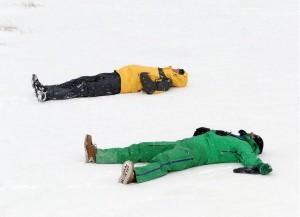
Our package trip included several excursions, plus we could opt to pay for additional excursions. Because there isn’t much else to do, and traveling on one’s own isn’t very feasible, we ended up signing up for all the excursions, except for the tundra tour. While the rest of the group was on the tundra tour we hiked the ridge above the airport. The path took us past the small rock quarry, and up onto the ridge. Views down the valley are tremendous, as also are views of the airport, since that is located just below the ridge. On the ridge we climbed across glacier carved rocks, crossed frozen lakes, and enjoyed our first experience of rugged Greenland.
The afternoon of “day one” we left for our first trip inland, a journey to the edge of the Russell Glacier. We joined about 12 other people, climbing into an arctic explorer type vehicle, a large all-wheel drive van, with enormous knobby tires, specifically designed for exploring in the harsh climate and terrain of Greenland. Along the hour drive inland we passed numerous white reindeer and several musk oxen. Both types of animals thrive in extremely cold conditions, doing best at temperatures well below zero. Near the glacier we turned off the rough gravel road and drove across a frozen rocky and grassy plain. The first sight of the glacier was awe inspiring. A cracked and jagged wall of ice loomed more than seventy feet high, with boulders of ice strewn all along the base. We climbed over fields of granite that had been ground smooth by the glaciers, anxious to get closer to the ice. It is too dangerous to stand right under the ice, but we were able to get close enough to feel extremely small and powerless compared to the size and strength of the glacier. After taking our fill of photos; we enjoyed hot chocolate and cookies while marveling at the wonder of nature.

Our final full day was spent hiking. In the morning we joined the guides for a trip up a nearby canyon, to see the river and waterfall. The river cuts a narrow channel through solid rock, and when spring arrives, it can grow to raging torrent of water. Spring was a bit late in arriving when we visited, and there was just a small trickle of water since the snow melt had not fully started. Our final dinner was a Greenlandinc feast, enjoyed at the Restaurant Roklubben, a rowing club at the edge of Lake Fergeson, a few minutes’ drive from Kangerlussuaq. There we sampled many types of fish and shrimp, and even had the opportunity to eat reindeer, musk ox, and whale. For being such a remote country, Greenlanders are fortunate to have such a bounty of local food readily available.
To say Greenland is large is really an understatement. As the world’s largest island, it is a place one could spend lifetimes exploring, but our trip was already coming to an end. As we took off for the four hour flight back to Copenhagen, we craned our necks and struggled to see out the airplane windows for one last glimpse of this enchanting and wondrous place.
